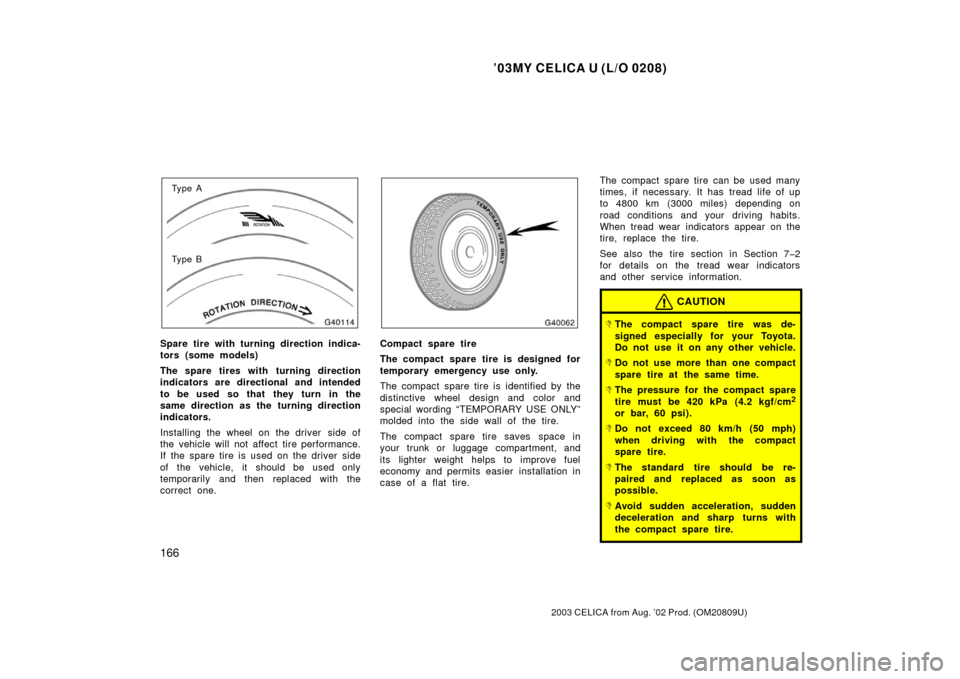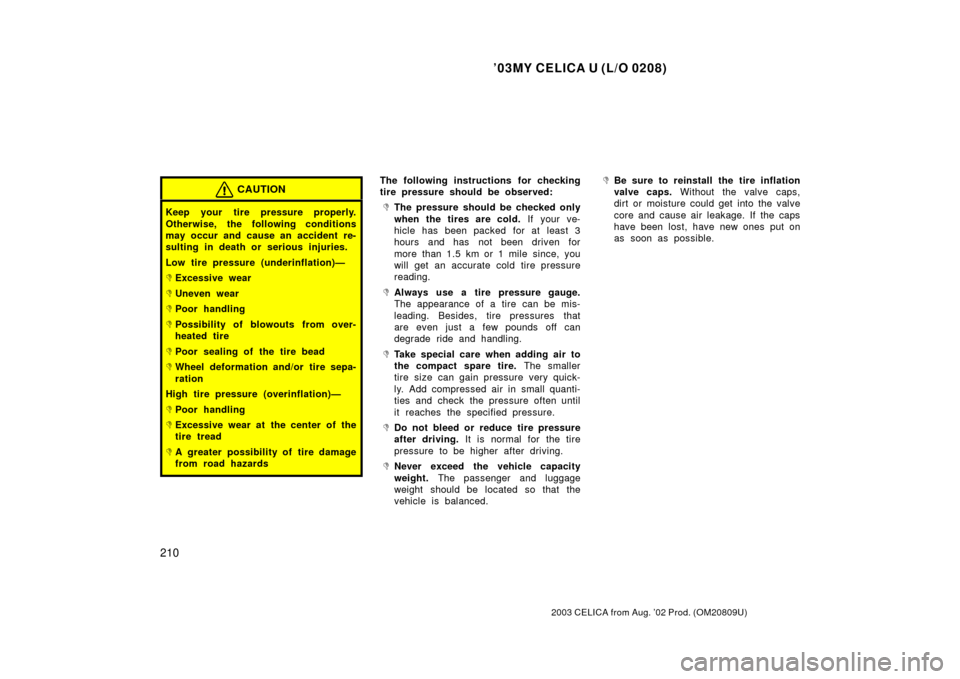Page 170 of 249

’03MY CELICA U (L/O 0208)
166
2003 CELICA from Aug. ’02 Prod. (OM20809U)
Ty p e A
Ty p e B
Spare tire with turning direction indica-
tors (some models)
The spare tires with turning direction
indicators are directional and intended
to be used so that they turn in the
same direction as the turning direction
indicators.
Installing the wheel on the driver side of
the vehicle will not affect tire performance.
If the spare tire is used on the driver side
of the vehicle, it should be used only
temporarily and then replaced with the
correct one.Compact spare tire
The compact spare tire is designed for
temporary emergency use only.
The compact spare tire is identified by the
distinctive wheel design and color and
special wording “TEMPORARY USE ONLY”
molded into the side wall of the tire.
The compact spare tire saves space in
your trunk or luggage compartment, and
its lighter weight helps to improve fuel
economy and permits easier installation in
case of a flat tire. The compact spare tire can be used many
times, if necessary. It has tread life of up
to 4800 km (3000 miles) depending on
road conditions and your driving habits.
When tread wear indicators appear on the
tire, replace the tire.
See also the tire section in Section 7�2
for details on the tread wear indicators
and other service information.
CAUTION
�The compact spare tire was de-
signed especially for your Toyota.
Do not use it on any other vehicle.
�Do not use more than one compact
spare tire at the same time.
�The pressure for the compact spare
tire must be 420 kPa (4.2 kgf/cm2
or bar, 60 psi).
�Do not exceed 80 km/h (50 mph)
when driving with the compact
spare tire.
�The standard tire should be re-
paired and replaced as soon as
possible.
�Avoid sudden acceleration, sudden
deceleration and sharp turns with
the compact spare tire.
Page 213 of 249

’03MY CELICA U (L/O 0208)
209
2003 CELICA from Aug. ’02 Prod. (OM20809U)
If hot
O.K.Close Open
If hot add If cold
add
If cold O.K.
Check the fluid level through the reser-
voir. If necessary, add automatic trans-
mission fluid DEXRON
�II or III.
If the vehicle has been driven around 80
km/h (50 mph) for 20 minutes (a little
more in frigid temperatures), the fluid is
hot (60 �C—80 �C or 140 �F—175 �F). You
may also check the level when the fluid
is cold (about room temperature,
10 �C—30 �C or 50 �F—85 �F) if the engine
has not been run for about five hours. Clean all dirt from outside of the reservoir
tank and look at the fluid level. If the fluid
is cold, the level should be in the “COLD”
range. Similarly, if it is hot, the fluid level
should be in the “HOT” range. If the level
is at the low side of either range, add
automatic transmission fluid DEXRON
�II or
III to bring the level within the range.
To remove the reservoir cap, turn it coun-
terclockwise and lift up. To reinstall it,
turn it clockwise. After replacing the reser-
voir cap, visually check the steering box
case, vane pump and hose connections
for leaks or damage.
CAUTION
The reservoir tank may be hot so be
careful not to burn yourself.
NOTICE
Avoid overfilling, or the power steer-
ing could be damaged.
Keep your tire pressures at the proper
level.
The recommended cold tire pressures, tire
size and the vehicle capacity weight are
given in Section 8. They are also on the
tire pressure label as shown.
You should check the tire pressures every
two weeks, or at least once a month. And
do not forget the spare!
Incorrect tire pressure may waste fuel,
reduce the comfort of driving, reduce tire
life and make your vehicle less safe to
drive.
If a tire frequently needs ref illing, have it
checked by your Toyota dealer.
Checking power steering fluid Checking tire pressure
Page 214 of 249

’03MY CELICA U (L/O 0208)
210
2003 CELICA from Aug. ’02 Prod. (OM20809U)
CAUTION
Keep your tire pressure properly.
Otherwise, the following conditions
may occur and cause an accident re-
sulting in death or serious injuries.
Low tire pressure (underinflation)—
�Excessive wear
�Uneven wear
�Poor handling
�Possibility of blowouts from over-
heated tire
�Poor sealing of the tire bead
�Wheel deformation and/or tire sepa-
ration
High tire pressure (overinflation)—
�Poor handling
�Excessive wear at the center of the
tire tread
�A greater possibility of tire damage
from road hazards
The following instructions for checking
tire pressure should be observed:
�The pressure should be checked only
when the tires are cold. If your ve-
hicle has been packed for at least 3
hours and has not been driven for
more than 1.5 km or 1 mile since, you
will get an accurate cold tire pressure
reading.
�Always use a tire pressure gauge.
The appearance of a tire can be mis-
leading. Besides, tire pressures that
are even just a few pounds off can
degrade ride and handling.
�Take special care when adding air to
the compact spare tire. The smaller
tire size can gain pressure very quick-
ly. Add compressed air in small quanti-
ties and check the pressure often until
it reaches the specified pressure.
�Do not bleed or reduce tire pressure
after driving. It is normal for the tire
pressure to be higher after driving.
�Never exceed the vehicle capacity
weight. The passenger and luggage
weight should be located so that the
vehicle is balanced.
�Be sure to reinstall the tire inflation
valve caps. Without the valve caps,
dirt or moisture could get into the valve
core and cause air leakage. If the caps
have been lost, have new ones put on
as soon as possible.
Page 220 of 249
’03MY CELICA U (L/O 0208)
216
2003 CELICA from Aug. ’02 Prod. (OM20809U)
�When installing aluminum wheels,
check that the wheel nuts are tight
after driving your vehicle the first 1600
km (1000 miles).
�If you have rotated, repaired, or
changed your tires, check that the
wheel nuts are still tight after driving
1600 km (1000 miles).
�When using tire chains, be careful not
to damage the aluminum wheels.
�Use only the Toyota wheel nuts and
wrench designed for your aluminum
wheels.
�When balancing your wheels, use only
Toyota balance weights or equivalent
and a plastic or rubber hammer.
�As with any wheel, periodically check
your aluminum wheels for damage. If
damaged, replace immediately.
Aluminum wheel precautions
Page 237 of 249
’03MY CELICA U (L/O 0208)
233
2003 CELICA from Aug. ’02 Prod. (OM20809U)
SPECIFICATIONS
Dimensions and weight234
. . . . . . . . . . . . . . . . . . . . . . . . . . . . . . . . . . . . \
. .
Engine 234
. . . . . . . . . . . . . . . . . . . . . . . . . . . . . . . . . . . . \
. . . . . . . . . . . . . . . .
Fuel 234
. . . . . . . . . . . . . . . . . . . . . . . . . . . . . . . . . . . . \
. . . . . . . . . . . . . . . . . . .
Service specifications 235
. . . . . . . . . . . . . . . . . . . . . . . . . . . . . . . . . . . . \
. . .
Tires 237
. . . . . . . . . . . . . . . . . . . . . . . . . . . . . . . . . . . . \
. . . . . . . . . . . . . . . . . .
Fuses 238
. . . . . . . . . . . . . . . . . . . . . . . . . . . . . . . . . . . . \
. . . . . . . . . . . . . . . . .
SECTION 8
Page 238 of 249
’03MY CELICA U (L/O 0208)
234
2003 CELICA from Aug. ’02 Prod. (OM20809U)
Overall length mm (in.) 4330 (170.5)
Overall width mm (in.) 1735 (68.3)
Overall height mm (in.) 1305 (51.8)
∗
Wheelbase mm (in.) 2600 (102.4)
Front tread mm (in.) 1490 (58.7)
Rear tread mm (in.) 1480 (58.3)
Vehicle capacity weight
(occupants + luggage)kg (lb.) 329 (725)
∗: Unladen vehicle Model:
1ZZ�FE and 2ZZ�GE
Type: 4 cylinder in line, 4 cycle, gasoline
Bore and stroke, mm (in.): 1ZZ�FE engine 79.0 � 91.5 (3.11 � 3.60)
2ZZ�GE engine
82.0 � 85.0 (3.23 � 3.35)
Displacement, cm
3 (cu. in.):
1ZZ�FE engine 1794 (109.5)
2ZZ�GE engine 1796 (109.6) Fuel type:
1ZZ�FE engineUnleaded gasoline, Octane Rating 87
(Research Octane Number 91) or
higher
2ZZ�GE engine Select premium unleaded gasoline with
an Octane Rating of 91 (Research Oc-
tane Number 96) or higher for opti-
mum engine performance
Fuel tank capacity, L (gal., Imp. gal.): 55 (14.5, 12.1)
Dimensions and weight EngineFuel